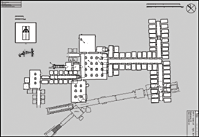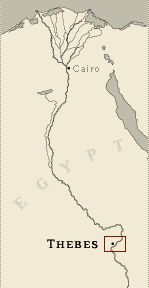|
KV 5 (Sons of Rameses
II)
General Site Information
Structure: KV 5
Location: Valley of the Kings, East Valley, Thebes West Bank, Thebes
Owner: Sons of Rameses II
Other designations: 5 [Lepsius], 8 [Hay], Commencement d'excavation
ou grotte bouchée [Description], M [Burton]
Site type: Tomb
Description
KV 5 is located in the main wadi of the
Valley of the Kings. The tomb may originally have been an Dynasty 18
tomb (consisting of chambers 1, 2, and part of 3) usurped by Rameses
II as the burial place for several of his principal sons. Still
under excavation, the tomb has so far revealed 121 corridors and
chambers. Since the tomb appears to have several bilaterally
symmetrical sections, it is likely that the number of chambers will
increase to 150 or more in subsequent field seasons. KV 5 itself is
the largest tomb in the Valley; pillared chamber 3 is the largest
chamber of any tomb in the Valley of the Kings.
At least six royal sons are known to have been interred in KV 5.
Since there are more than twenty representations of sons carved on
its walls, there may have been that many sons interred in the tomb.
The tomb is decorated with scenes from the Opening of the Mouth
ritual (pillared chamber 3) and representations of the king, princes
and deities (chamber 1, chamber 2, gate 3, pillared chamber 3,
corridor 7, chamber 8, gate 9, corridor 12).
Noteworthy features
The overall plan of this tomb is
unusual: there is a change in the tomb's principal axis after
chamber 3; several chambers lie beneath other chambers; two
corridors extend toward the northwest beneath the entrance and the
road in front of the tomb; the plan is unlike any other royal tomb.
Pillared chamber 3 has more pillars (sixteen) than any other chamber
in the Valley of the Kings. The sculpted Osiris figure in the recess
at the end of corridor 7 is unique.
Site History
A small tomb perhaps dating to Dynasty 18 was appropriated by
Rameses II and considerably enlarged in several phases. There is no
evidence of re-use of KV 5 after the reign of Rameses II. The tomb
was first visited in modern times by James Burton, who mapped its
first nine chambers. Its greater extent was realized by the Theban
Mapping Project in 1995, and more chambers continue to be discovered
until today.
Dating
This site was used during the following period(s):
New Kingdom, Dynasty 18 (entryway A,
chambers 1 and 2, and part of pillared chamber 3)
New Kingdom, Dynasty 19, Rameses II
History of
Exploration
Burton, James (1825): Mapping/planning
Carter, Howard (1902): Visit
Theban Mapping Project (1987-): Epigraphy
Theban Mapping Project (1987-): Excavation
Theban Mapping Project (1994-): Conservation
Theban Mapping Project (1995-): Photography
Conservation
-
Conservation history: The tomb is currently undergoing engineering
and conservation work as it continues to be cleared.
-
Site condition: The tomb was robbed in antiquity. Since then, it has
been hit by at least eleven flash floods caused by heavy rains in
the Valley. These have completely filled the tomb with debris and
seriously damaged its comprehensively decorated walls. From about
1960 to 1990, tour buses parked above the tomb; their vibrations
caused serious damage to parts of the tomb near the roadway, as did
a leaking sewer line installed over the entrance when the Valley of
the Kings rest house was built.
|

Printable Tomb Drawings
Axis in degrees: 134.18
Axis orientation: Southeast
Site Location
Latitude: 25.44 N
Longitude: 32.36 E
Elevation: 169.87 msl
North: 99,637.895
East: 94,095.771
JOG map reference: NG 36-10
Modern governorate: Qena (Qina)
Ancient nome: 4th Upper Egypt
Surveyed by TMP: Yes
Measurements
Maximum height: 2.85 m
Minimum width: 0.61 m
Maximum width: 15.43 m
Total length: 443.2 m
Total area: 1266.47 m²
Total volume: 2154.82 m³
Additional Tomb Information
Entrance location: Valley floor
Owner type: Prince
Entrance type: Staircase
Interior layout: Corridors and chambers
Axis type: Straight
Decoration
Grafitti
Painting
Raised relief
Categories of Objects Recovered
Human remains
Jewellery
Mammal remains
Religious objects
Tomb equipment
Transport
Vessels
Written documents
|

